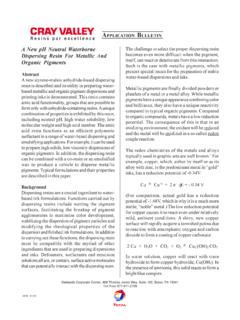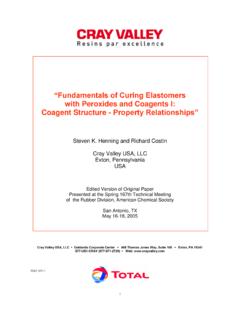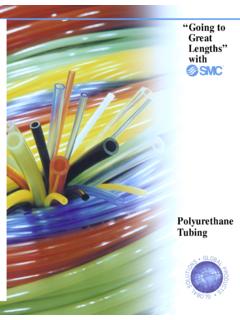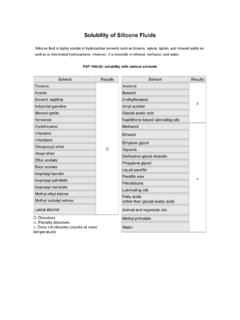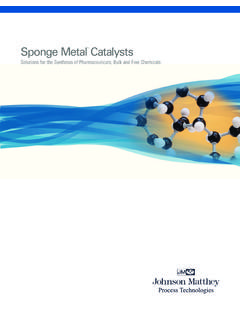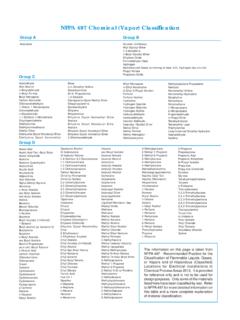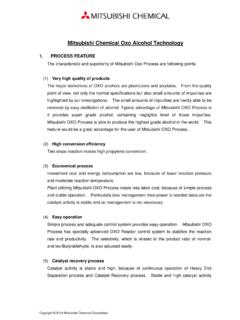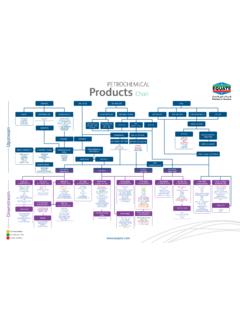Transcription of SMA Resins in Solvent Based Formulations - Cray …
1 SMA Resins in Solvent BasedFormulationsIntroductionSMA Resins are a family of low molecular weightcopolymers of styrene and maleic anhydride. Thedifferent Resins within the product line have a varietyof chemical structures and exhibit a range ofproperties, such as acid equivalent value, softeningrange and solubility. SMA 1000, 2000, 3000 and4000 are base Resins with styrene/maleic anhydrideratios equal to 1, 2, 3, and 4, respectively, whileSMA 1440, 17352, 2625, and 3840 are partiallyesterified derivatives of SMA base Resins whichcontain ester, carboxylic acid and Resins are currently used in Solvent basedformulation systems such as printing inks, woodlacquers and varnishes where they provide enhancedproperties such as high gloss, water resistance, heatresistance, color development and low viscosity. Thisbrochure is designed to assist you in gaining themaximum benefit from including SMA Resins inyour Solvent - Based Formulations .
2 First, a full studyof the solubility of SMA in various solvents is , the compatibility of SMA Resins with other resinscommonly found in Solvent - Based Formulations isdetailed. Finally, typical advantages achieved by usingSMA Resins in Solvent - Based applications are listed inthe last part of this Solubility of SMA ResinsThe Solvent formulating map, shown in Figure 1, suggestspotential solvents for use with SMA Resins . Thisinformation provides a starting point to quickly developoptimum SMA -containing Solvent systems with aminimum of research principle behind the development of the solventformulating map for SMA is Based on the concept thatsolvent action depends primarily on two characteristicsof the Solvent : Hildebrands solubility parameter, delta(d), and the hydrogen bonding index, gamma (g). Inregards to the second parameter, solvents can beclassified according to the relative strengths of theirhydrogen bonds: Weakly hydrogen bonded, moderatelyhydrogen bonded and strongly hydrogen bonded.
3 Table1 shows the range of g for each class along with typicalsolvents in each 01/10 Table 1: Classification of solvents by Their Hydrogen - Bonding IndexDegree of Hydrogen BondingHydrogen-binding index ( )Typical solventsWeakly bonded< , Cycloaliphatic, Aromatic,Chlorinated hydrocarbons, NitroalkanesModerately - , Esters, KetonesStrongly bonded> , Amines, AcidsAPPLICATION BULLETINO aklands Corporate Center, 468 Thomas Jones Way, Suite 100, Exton, PA 19341 Toll Free 877-871-272923 Table 2 listings the values of and for many of thesolvents that may be of interest in preparing SMA Formulations . Plotting the solubility parameter vs. thehydrogen-bonding index of any Solvent or solventblend results in a single point in a map. By determiningthe solubility of SMA in a variety of solvents , it isthen possible to define the area of the chart within whichactive solvents are located and beyond which completesolubility in general is not attained.
4 Following theprocedure of the ASTM D-3132 standard testmethod, the solubility map for SMA Resins (Figure1) is Based upon room temperature solubility carriedout using 50% solids (by weight) in a range of solventsand Solvent blends. The contour line encloses the regionfor compete solubility. The contours have been drawnto exclude borderline solvents , , those in whichcloudy solutions were demonstrate the use of the Solvent map, considerdioxane, which has a solubility parameter of and ahydrogen-bonding index of This point falls withinthe contours of the map and, hence, SMA gives aclear solution (50% solids by weight) in this the other hand, pentane, with a solubility parameterof and a hydrogen bonding index of , fallsoutside the contours of the map and, hence, SMA ininsoluble in mixtures or blends of solvents are used, thesolubility parameter and hydrogen bonding indexvalues for the mixture are calculated by adding theproducts of the volume fractions and d and g for eachof the solvents in the blend.
5 Therefore, by correctlychoosing, it is possible to find mixtures of non-solventswhose calculated solubility and hydrogen bondingindex values lie within the contour lines of the solventmap. As a practical matter, the point representing theproposed Solvent or Solvent blend should be locatedwell inside the enclosed area on the map for maximumassurance that a clear solution will be obtained. Finally,any Solvent system devised using a formulating mapshould, of course, be checked in the laboratory beforeit is adopted for commercial use. Also refer to the CrayValley Product Bulletin SMA Multi-FunctionalResins , to find a table of experimental solubility of the Solvent Solubility Parame te r ( )Hydrogen Bonding Inde x ( ) 1,1, (EGMEE) ether Acetate Glycol Acetate acetate benzoate carbinol ropanol ropyl entanol ropylene carbonate ropylene glycol ropylene 2: Solubility Parameters and HydrogenBonding Indices of Common solvents 4 The solubility maps (Figure 1) highlight severaldifferences in solubility properties amongst the differentgrades of SMA.
6 First, in general, esterified SMA Resins (1440, 17352, 2625) are soluble in a wider rangeof solvents than the base SMA Resins (1000, 2000,3000, 4000). For example, a number of alcohols ( = ) are true solvents for esterified SMA Resinsbut not for the base Resins . The solubility maps alsoindicate that the solubilities of the base SMA Resinsare related to their SMA composition. Specifically,base Resins such as 1000 and 2000 grades with lowSMA composition (high acid numbers) exhibit bettersolubility in strongly hydrogen bonding Compatibility of SMA Resins withother common resinsProperties of Solvent - Based Formulations oftendepend upon the presence of a mixture of polymericresins. Therefore, to have general utility in this area, itis important for a resin additive to be compatible witha variety of commonly used modifying Resins . Thecompatibility of SMA Resin solutions to the presenceof other Resins was determined by observing thesolubilitys of solutions of resin mixtures, varying incomposition from 10/1 to 1/10 (SMA /modifyingresin).
7 If a mixture forms a clear stable solution theresins are considered to be compatible. The generalcompatibility properties of SMA with differentclasses of modifying Resins are described in Table 4,while a more specific study investigating the propertiesof SMA /polyamide mixtures is summarized inTable 5. These results point out that SMA is highlycompatible with a variety of commonly used modifyingresins over a wide range of 4: Compatibility of SMA Resins with Common Classes of ResinsTable 5: Compatibility of SMA Resins with Polymide ResinsModifying ResinSolventCompatibilityCellulosicsEtha nol, IsopropylIn All RatiosAcetate, Toluene (1:1:1 Mixture)RosinatesAlcohol or EsterIn All RatiosPolyesters/PolyketonesAlcoholIn All RatiosAcrylicsEhtanol, Isopropyl AcetateIn All RatiosToluene (1:1:1 Mixture)VinylsMEKIn All RatiosPolymide Resin (RI) Solvent SelectedR1/RSMA Resin (R)TypeName262517352 AlcoholSoluble PolymideUnirez 2209 (Union Camp) Ethanol + Lactone (1/1)10/11/11/10 IncompatibleIncompatibleCompatibleCompat ibleCompatibleCompatibleUnirez2209 (Union Camp) Ethanol + Toluene (80/20) 10/11/11/10 CompatibleCompatibleCompatibleCompatible CompatibleSlightly IncompatibleVersamide 750 (Cognis)Ethanol + Lactone (1/1)10/11/11/10 CompatibleCompatibleCompatibleIncompatib leIncompatibleIncompatibleVersamide 750 (Cognis)Ethanol + Toluene (80/20) 10/11/11/10 CompatibleCompatibleCompatibleCompatible CompatibleCompatibleCoSolventPolyamideUn irez 2930 (Union Camp) Ethanol + Lactone (1/1)10/11/11/10 CompatibleCompatibleIncompatibleCompatib leCompatibleIncompatibleVersamide 940 (Cognis)Ethanol + Toluene (80/20)
8 10/11/11/10 CompatibleIncompatibleIncompatibleCompat ibleCompatibleIncompatible5 Benefits of Using SMA Resins in SolventBased ApplicationsSMA Resins are soluble in a variety of solvents andare compatible with many other types of Resins , so itis possible to add them to a wide range of Solvent - Based applications. The advantages that SMA Resinsbring to a number of specific application areas arehighlighted in the following Printing Inks - Dye InksFlexographic dye inks are generally solutions of dyeand phenolic resin in ethanol, which is mainly used inprinting decorative paper. A typical formulation is:Dye15%Phenolic Resin20%Ethanol65%When used as a binder in flexographic dye inks,SMA 17352 improves the water resistance, the gloss,and the color development. A typical SMA basedformulation is:Dye10-15%Phenolic Resin0-10%SMA 1735215-20%Ethanol60-65% - Nitrocellulose (Cellulose Nitrate) Printing InksSMA Resins improve a range of properties whenadded to nitrocellulose Based ink Formulations .
9 SMA 17352 or SMA 2625 can be particularly beneficialto ink properties when added at a 2-5% level. Additionof SMA Resins to there ink Formulations improvesproperties such as: Adhesion: SMA Resins improve adhesion tonon-porous substrates, such as aluminum,polypropylene, etc. Gloss: Nitrocellulose inks generally have lowergloss than polyamide inks, but addition ofSMA Resins improves the gloss withoutaffecting other ink properties. Heat Resistance: SMA Resins have outstandingthermal resistance and give a more heat stableink. Water Resistance: SMA Resins show goodresistance to water, a property that is impartedto the final ink. Low Viscosity: Low Molecular Weight SMA Resins do not change the viscosity of liquid inks. Blocking Resistance: The heat resistanceimprovement results directly in an increase ofthe blocking resistance, an essential requirementfor a printing process to run smoothly. - Polyamide Printing InksAlcohol soluble polyamide Based inks are commonlyused for printing plastic film, an application where heatresistance is not required.
10 If moderate heat resistanceis needed, it can be achieved by replacing pare of thealcohol soluble polyamide with nitrocellulose, but onlyat the expense of decreased gloss. Alternatively, theaddition of SMA Resins to polyamide Based inkscan improve the level of heat resistance whilemaintaining high gloss Wood LaquersSMA Resins can be used as additives in theproduction of nitro- or ethyl cellulose- Based woodlacquers. Due to their low molecular weight, SMA Resins give low viscosity Formulations while providinghigh resistance to water. A typical formulation couldbe:Nitro- or Ethyl-cellulose10-15%Plasticizer10-15%Et hanol 35%Acetate Butyl and Ethyl 30%SMA 1735210-15%The information in this bulletin is believed to be accurate, but all recommendations are made without warranty since the conditions of use are beyond Cray Valley Company'scontrol. The listed properties are illustrative only, and not product specifications.
